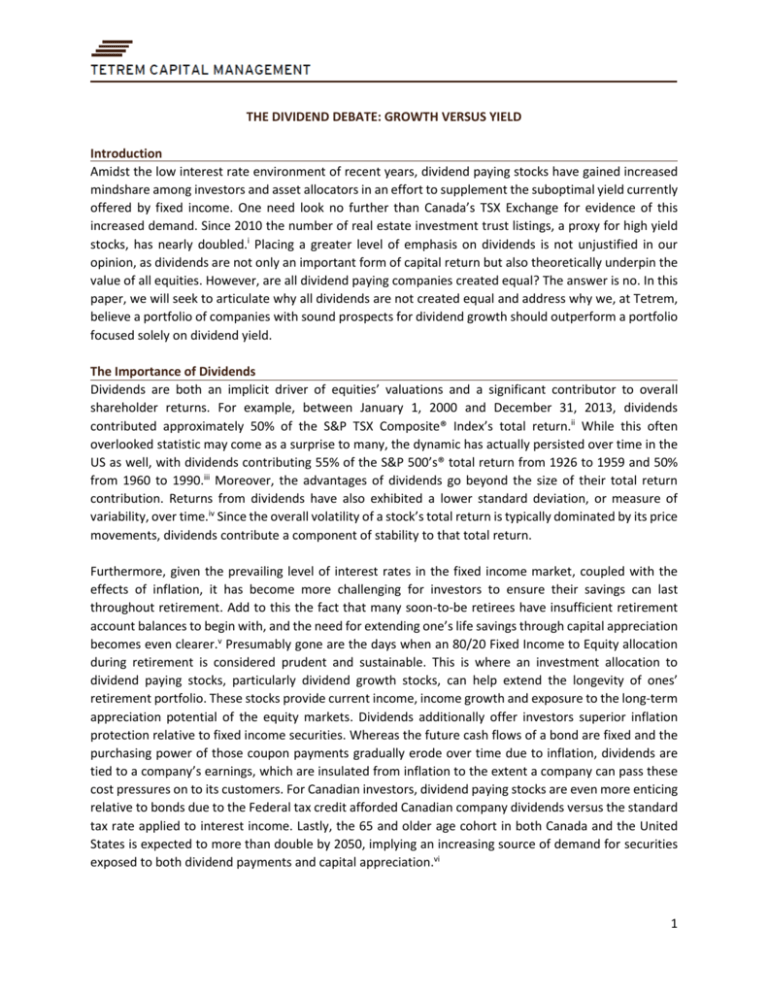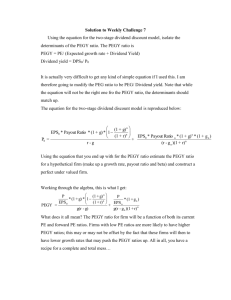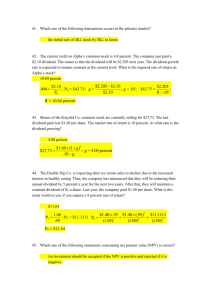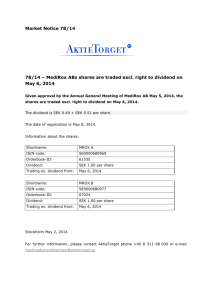
THE DIVIDEND DEBATE: GROWTH VERSUS YIELD
Introduction
Amidst the low interest rate environment of recent years, dividend paying stocks have gained increased
mindshare among investors and asset allocators in an effort to supplement the suboptimal yield currently
offered by fixed income. One need look no further than Canada’s TSX Exchange for evidence of this
increased demand. Since 2010 the number of real estate investment trust listings, a proxy for high yield
stocks, has nearly doubled.i Placing a greater level of emphasis on dividends is not unjustified in our
opinion, as dividends are not only an important form of capital return but also theoretically underpin the
value of all equities. However, are all dividend paying companies created equal? The answer is no. In this
paper, we will seek to articulate why all dividends are not created equal and address why we, at Tetrem,
believe a portfolio of companies with sound prospects for dividend growth should outperform a portfolio
focused solely on dividend yield.
The Importance of Dividends
Dividends are both an implicit driver of equities’ valuations and a significant contributor to overall
shareholder returns. For example, between January 1, 2000 and December 31, 2013, dividends
contributed approximately 50% of the S&P TSX Composite® Index’s total return.ii While this often
overlooked statistic may come as a surprise to many, the dynamic has actually persisted over time in the
US as well, with dividends contributing 55% of the S&P 500’s® total return from 1926 to 1959 and 50%
from 1960 to 1990.iii Moreover, the advantages of dividends go beyond the size of their total return
contribution. Returns from dividends have also exhibited a lower standard deviation, or measure of
variability, over time.iv Since the overall volatility of a stock’s total return is typically dominated by its price
movements, dividends contribute a component of stability to that total return.
Furthermore, given the prevailing level of interest rates in the fixed income market, coupled with the
effects of inflation, it has become more challenging for investors to ensure their savings can last
throughout retirement. Add to this the fact that many soon-to-be retirees have insufficient retirement
account balances to begin with, and the need for extending one’s life savings through capital appreciation
becomes even clearer.v Presumably gone are the days when an 80/20 Fixed Income to Equity allocation
during retirement is considered prudent and sustainable. This is where an investment allocation to
dividend paying stocks, particularly dividend growth stocks, can help extend the longevity of ones’
retirement portfolio. These stocks provide current income, income growth and exposure to the long-term
appreciation potential of the equity markets. Dividends additionally offer investors superior inflation
protection relative to fixed income securities. Whereas the future cash flows of a bond are fixed and the
purchasing power of those coupon payments gradually erode over time due to inflation, dividends are
tied to a company’s earnings, which are insulated from inflation to the extent a company can pass these
cost pressures on to its customers. For Canadian investors, dividend paying stocks are even more enticing
relative to bonds due to the Federal tax credit afforded Canadian company dividends versus the standard
tax rate applied to interest income. Lastly, the 65 and older age cohort in both Canada and the United
States is expected to more than double by 2050, implying an increasing source of demand for securities
exposed to both dividend payments and capital appreciation.vi
1
Evidence Favors Dividend Growth
In light of the importance of dividends for investors, the question then becomes in which pond of dividend
paying companies should an investor fish? Current data strongly suggests that the answer to that question
is companies growing their dividend rather than companies simply offering a high dividend yield. In what
follows we will refer to stocks that have increased their dividends at a faster rate than the overall market,
and are expected to continue doing so, as dividend growers (or “growers”). Conversely, we refer to those
that pay an above average dividend relative to their share price as dividend yielders (or “yielders”).
To test our belief that growers should outperform yielders over time, we constructed a back-test analysis
to compare the cumulative total return performance of the two dividend strategies. We built two equally
weighted, dividend paying stock portfolios using companies from the S&P 500® Index. The yielders
portfolio was comprised of the highest yielding quintile of stocks in the Index, while the growers portfolio
was comprised of the quintile of stocks exhibiting the fastest three year historical dividend growth rates.
These two portfolios were then rebalanced annually in the simulation. The growers generated the highest
cumulative return over the entire period, September 30, 1994 through September 30, 2014, returning
937% (CAGR of 12.4%) (Exhibit 1). The growers outperformed the yielders’ return of 881% (CAGR of 12.1%)
by a cumulative 56 percentage points.
Exhibit 1: Dividend Growth Vs Dividend Yield Back-test
(Cumulative Return in Percentage)
Dividend Yielders
Dividend Growers
Sep-14
Sep-13
Sep-12
Sep-11
Sep-10
Sep-09
Sep-08
Sep-07
Sep-06
Sep-05
Sep-04
Sep-03
Sep-02
Sep-01
Sep-00
Sep-99
Sep-98
Sep-97
Sep-96
Sep-95
Sep-94
1,000
900
800
700
600
(%) 500
400
300
200
100
0
S&P 500
Source: Bloomberg, Tetrem Capital Management, Back-test is for illustrative purposes only. Past performance does not guarantee
future results. Different types of investments involve varying degrees of risk.
Despite the compelling results of our back-test model, this is far from the sole driver of our support for a
dividend growth strategy. The practice of value investing is at the core of Tetrem’s philosophy, thus a
consideration for which dividend stocks are more attractively valued is paramount. Using trailing twelve
month price-to-earnings (P/E) multiples as a measure of valuation, we find that dividend growth is more
attractive on a relative value basis. As of August 2014, dividend growers offered a P/E multiple relative to
2
dividend yielders well below the long-term average and, in fact, traded at a level seen only 10% of the
time, on a monthly basis, since 1952 (Exhibit 2).
Exhibit 2: Trailing Relative P/E Multiples of Dividend Growth and Dividend Yield Stocks
3.5 x
Dividend Growth Expensive Vs Dividend Yield
3.0 x
Average since
1952
2.5 x
2.0 x
1.5 x
1.0 x
Dividend Growth Is Cheap Vs Dividend Yield
0.5 x
0.0 x
80
82
84
86
88
90
92
94
96
98
00
02
04
06
08
10
12
14
Source: Empirical Research Partners.
Although relative valuation is a strong
Exhibit 3: S&P 500 Corporations’ Cash as a
argument in favor of dividend growth over
Percentage of Total Assets
dividend yield, the capacity for dividend
12%
growth stocks to continually increase their
dividend is another key element. Cash
balances for the constituents of the S&P 10%
500® Index are at their highest levels in over
two decades (Exhibit 3). This serves as an
8%
indication that companies interested in
increasing their dividend have the
wherewithal to do so. However, cash on the
6%
balance sheet is not the only way to
measure this ability, with the dividend
4%
payout ratio arguably a superior metric. The
dividend payout ratio measures the
proportion of a company’s earnings
2%
distributed to shareholders as a dividend
and demonstrates the degree to which a
0%
company’s profits can fund and grow that
90 92 94 96 98 00 02 04 06 08 10 12
dividend. For example, consider two
Source: Bloomberg, Tetrem Capital Management
companies in the same industry: Firm A which
has a payout ratio of 20% and Firm B, which has a payout ratio of 90%. Clearly, Firm A has more flexibility
to increase its dividend in the future. Now consider what would happen if their industry hits a rough patch
and earnings decline 20%? Firm A’s dividend is well protected while firm B’s dividend may be at risk of
being cut. Fortunately for an allocation to dividend growth, the payout ratio of the market (measured by
the S&P 500® Index) as of the first quarter of 2014, was a manageable 32%, well below the 54% average
payout ratio seen since 1900.vii
3
One point a dividend yield advocate might raise is that stocks with a higher yield provide investors with a
greater level of current income. While it is true that stocks with higher dividend yields, by definition,
produce a level of income on the current capital invested above that of dividend growers, this yield
differential is lower than it has been in over twenty years (Exhibit 4). Said differently, the magnitude of
this key benefit for yielders over growers is smaller today than at any point since 1990. This is a function
of investors, in their quest for yield, bidding up the price of yielders well beyond their historical valuation
relative to growers. This could ultimately revert with a decline in the share price of yielders in response to
reduced investor demand for yield via “bond proxies”. Somewhat counterintuitively, growers may even
provide greater cash flow than yielders over a longer-term investment horizon. For example, consider two
stocks priced at $50: stock ABC with a dividend of $1.75 (a current yield of 3.5%) growing at 3%, and stock
XYZ with a dividend of $0.75 (a current yield of 1.5%) growing at 20%. Assuming dividends are not
reinvested, after just 7 years stock XYZ will have a higher dividend yield on the initial $50 share price than
ABC and, after 11 years, will generate more cumulative dividend income.
Exhibit 4: Yield Differential of High Dividend Yield versus High Dividend Growth
Stocks within the S&P 500
6%
5%
4%
3%
2%
1%
Nov-13
Oct-12
Sep-11
Aug-10
Jul-09
Jun-08
May-07
Apr-06
Mar-05
Feb-04
Jan-03
Dec-01
Nov-00
Oct-99
Sep-98
Aug-97
Jul-96
Jun-95
May-94
Apr-93
Mar-92
Feb-91
Jan-90
0%
Source: Brian Belski, “Dividend Growth Matters Most”, Bank of Montreal, September 12, 2014: 3.
Since stocks with high dividend yields have characteristics of fixed income securities, we would be remiss
if we did not briefly address the current interest rate environment. As we continue to operate in an
environment with interest rates at the low end of their historical range, it is not unreasonable to expect
rates to eventually rise (though we do not pretend to know exactly when this will be). This ensuing
development will certainly be a negative for bond prices (interest rates and bond prices move inversely)
and should also be a headwind for high dividend yield, “bond proxy” stocks. Yielders have historically
exhibited a slight negative correlation with changes in 10-year Treasury yields. viii That is, as the yield on
the 10-year Treasury rises, the total return of yielders tends to decline while the total return of growers
does not. So when interest rates eventually do rise, a portfolio allocation to dividend yield is likely to have
greater downside risk than an allocation to dividend growth.
4
Conclusion
The evidence for pursuing a dividend growth strategy is compelling. Dividend growth stocks have rarely
traded at such a low relative valuation multiple to yielders as they are today. The excess current yield
offered by dividend yielders versus dividend growers is as small as it has been in over 20 years. Similarly,
given robust corporate balance sheets and low payout ratios, seldom has an environment been more
conducive to dividend increases. Dividend growth stocks offer an excellent combination of income
growth, capital appreciation potential and inflation protection. And by the way, dividend yielders, or
“bond proxies”, tend to underperform in a rising rate environment and interest rates will most likely not
stay at today’s low levels forever. So if dividend growth stocks are an attractive allocation of investment
capital, which dividend growers are the right ones? That is where Tetrem believes its bottom-up, valuedriven investment research process comes into play. Uncovering the dividend growth stocks with the best
fundamentals that support dividend and earnings growth will bolster the powerful tailwinds we see
developing for dividend growth stocks today.
About Tetrem
Tetrem Capital Management is an employee-owned investment management firm that specializes in
managing large cap, value-oriented portfolios. Tetrem offers Canadian and U.S. Equity Value strategies
as well as Canadian and U.S. Dividend Growth strategies.
Tetrem’s talented team of 10 investment professionals work collaboratively to employ a bottom-up,
fundamental research process focused on finding value opportunities in the large capitalization
segment of the market. We are disciplined value investors in the purest sense.
For more information about Tetrem Capital Management please visit our website, www.tetrem.com.
The contact of this paper is intended for information purposes only and does not constitute an offer to buy or sell products or services of Tetrem
nor is it intended and/or financial advice on any subject matter or specific security mentioned. Any commentaries, reports or other content are
provided for your information only.
©2014 Tetrem Capital Management Ltd. All rights reserved. This communication does not constitute as an offer or solicitation by anyone in any
jurisdiction in which such an offer is not allowed. Tetrem’s advisory services are available only in those jurisdictions in which Tetrem Capital
Management is registered to provide such services.
i
Alex Avery, “Canadian REITs Monthly”, CIBC Institutional Equity Research, September 23, 2014: 1.
Bloomberg, Tetrem Capital Management. Weekly compounding with dividends reinvested. Total return =
122.85%, Price change = 61.50%
iii
Pankaj N. Patel, “Sustainable and Growing Dividend Portfolio”, ISI Quantitative Research, August 2, 2013: 2.
iv
Ibid., 2.
v
Pooneh Baghai, “Are Canadians Ready for Retirement?”, McKinsey&Company, April 2012: 12 and Nasrin
Dalirazar, “Can Americans Afford to Retire?”, US Census Bureau, October 2010: 17.
vi
United States Census Bureau 2012 National Population Projections
(http://www.census.gov/population/projections/data/national/2012/summarytables.html) and Statistics Canada
Population Projections for Canada, Provinces and Territories (http://www.statcan.gc.ca/pub/91-520x/2010001/aftertoc-aprestdm1-eng.htm) (both accessed September 10, 2014)
vii
Savita Subramanian, “The Power of Dividend Growth”, Bank of America Merrill Lynch, February 18, 2014, p. 3
viii
Ibid., 4. Study period from 1986 to 2014; total return correlation with changes in 10-Yr Treasury Yields for
Yielders was -11.8% and for growers was +1.5%.
ii
5







